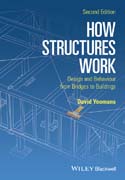
How Structures Work: Design and Behaviour from Bridges to Buildings
Yeomans, David
Structural engineering is central to the design of a building. How the building behaves when subjected to various forces the weight of the materials used to build it, the weight of the occupants or the traffic it carries, the force of the wind etc is fundamental to its stability. The alliance between architecture and structural engineering is therefore critical to the successful design and completion of the buildings and infrastructure that surrounds us. Yet structure is often cloaked in mathematics which many architects and surveyors find difficult to understand. How Structures Work has been written to explain the behaviour of structures in a clear way without resorting to complex mathematics. This new edition includes a new chapter on construction materials, and significant revisions to, and reordering of the existing chapters. It is aimed at all who require a good qualitative understanding of structures and their behaviour, and as such will be of benefit to students of architecture, architectural history, building surveying and civil engineering. The straightforward, non–mathematical approach ensures it will also be suitable for a wider audience including building administrators, archaeologists and the interested layman. INDICE: Preface .1 Brackets and Bridges .Cooper s tragedy .The Forth Bridge .Members in compression .The Quebec Bridge .Forces in a bracket .The design process .Stresses .2 Stiffening a Beam Girder Bridges .The simple truss .Tension trusses .Girder bridges: the Forth Bridge .3 Arches and Suspension Bridges .Building an arch .Blackfriars Bridge .Pontypridd Bridge .The forces in an arch .Practical issues .Forces within the arch ring .Edwards s failure .An unexpected failure .Arch with point load .Iron and concrete arches .The suspension bridge .Arches in buildings flying buttresses .Arches in walls .4 Bringing the Loads to the Ground The Structural Scheme .Introduction .The alternatives .Nature of the loads .Choices . Flow of forces , or action and reaction .Describing the structure .Structures are three–dimensional .Statically indeterminate structures .5 Safe as Houses? Walls .Bricks and mortar .Point loads and openings .Cavity walls .Thick walls .Foundation loads .Horizontal loads .Rafter thrusts .Foundation stresses .6 Frames A Problem of Stability .Timber framing .Bracing forces .Bending in the post .Light frame construction .The coming of iron .The frame today .The multi–storey frame .Columns .7 Floors and Beams Deflections and Bending Moments .The need for science .Floors and deflections .The forces in the beam .Strain .Galileo s cantilever .Finding the stresses .From cantilever to beam .Iron and steel beams .Cast iron .Reinforced concrete beams .Continuous beams .Shear .Two–way floors .Other structures in bending .Prestressing .8 Providing Shelter Roofs .Common rafter roofs .Purlin roofs .Longitudinal stability .The roof truss .The coming of iron .Three–dimensional roofs .9 Structures in a Three–dimensional World .Vaults .The pointed vault .Elaborations on the basic vault form .Building vaults .Domes .Some historical examples .The modern three–dimensional structure .Anticlastic forms .Structures in tension .Structures for their time and place .10 Materials and workmanship .Walling materials .Timber .Iron and steel .Concrete .Compatibility of materials .Material development and design .Appendix: Some Elements of Grammar .Glossary .Index
- ISBN: 978-1-119-01227-6
- Editorial: Wiley–Blackwell
- Encuadernacion: Rústica
- Páginas: 272
- Fecha Publicación: 11/12/2015
- Nº Volúmenes: 1
- Idioma: Inglés
